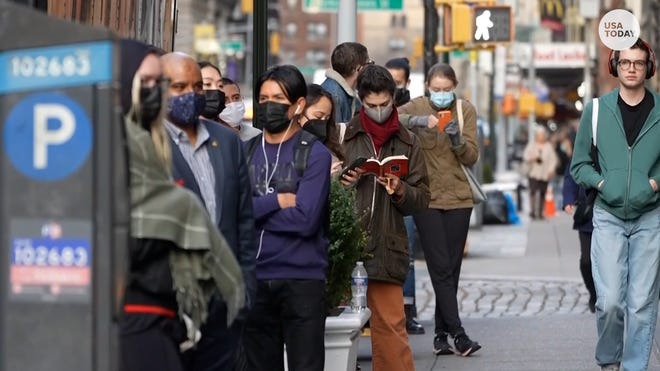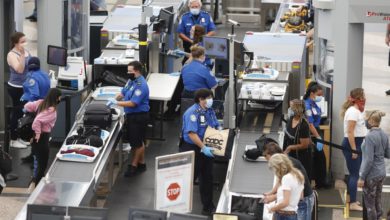

- The Tokyo Olympics officially begin Friday with the opening ceremony in Japan.
- U.S. flag-bearers are Sue Bird (women's basketball) and Eddy Alvarez (baseball).
- Roughly 200 members of U.S. delegation expected to march.
TOKYO — The Olympics are officially here.
The Tokyo 2020 Summer Games start with the opening ceremony, which will air live in the U.S. on Friday (7 a.m. ET, NBC), one day shy of when it was originally scheduled to take place in 2020.
About 950 spectators, mostly dignitaries — such as first lady Jill Biden — and journalists, will be at Olympic Stadium for the subdued festivities. The U.S. Olympic and Paralympic Committee said more than 200 athletes, led by flag-bearers Sue Bird (women's basketball) and Eddy Alvarez (baseball) are expected to march during the ceremony.
Follow along for live updates of the Tokyo Olympics.
CHECK OUT OUR GRAPHIC NOVEL: "Why Simone Biles is The GOAT"
INSIDE THE OLYMPIC VILLAGE: What's life like for Olympians in Tokyo?
Ralph Lauren’s Team USA opening ceremony uniform
While the flag-bearers will wear a white jacket, the rest of Team USA has been outfitted by Ralph Lauren in a navy blazer (made from US-grown wool), a striped T-shirt, a printed scarf, shoes and — it’s still a pandemic — mask. All materials have an element of sustainability and environmentalism.
Parade of nations, organized by Japanese alphabet, begins
After an opening that lasted 45 minutes, on the shorter end given the circumstances, the parade of nations began and is expected to last two hours. As is custom, Greece — where the modern Olympics began in 1896 — went first.
The order of nations marching won't be totally normal, as it goes in alphabetical order of the host country's alphabet. In this case, Iceland and Ireland went after the Refugee Olympic Team, which marched second. Another example: the Virgin Islands went eighth.
The future host countries of the Summer Games march toward the end of the program, meaning the United States (2028 Los Angeles) and France (2024 Paris) will precede the Japanese delegation, which will go last.
Tribute to 1964 Tokyo Olympics, Japanese history
Honoring Japan’s culture and tradition (ancient carpentry), a performance symbolizing the “construction of the Games” was highlighted by the construction of the wooden Olympic rings. The venues and the Olympic Village at the Tokyo 2020 Olympic and Paralympic Games have been constructed using lumber from thinned trees taken from all over Japan, to showcase the Japan’s lumber culture.
A ring of fireworks followed.
Japanese flag enters stadium
Once Emperor Naruhito and International Olympic Committee president Thomas Bach took their places on the official stand, the flag was carried by a combination of four athletes, a person with an impairment and a healthcare professional. A prayerful rendition of the Japanese national anthem, performed by Misia followed.
In the middle of the venue is a small replica of Mt. Fuji, a landmark of the country.
Black musician says race played role in opening ceremony removal
A musician originally from Senegal who has lived in Japan for more than two decades, Latyr Sy, said Tokyo 2020 organizers eliminated his role during the opening ceremony showcase because of his race, according to The Independent.
The Independent reported that a member of the organizing committee raised concerns that his inclusion would mean having to hire more diverse faces.
“It’s totally racist,” Sy told the outlet. “I was told they said ‘Why this guy? Why this African guy?’ I’ve seen a lot of stuff, I’ve felt a lot of things, but this just doesn’t fit with the Olympics. Why should I be silent?
“I’m afraid to talk but I’m just ready to let it out. I want to share my story. I’m not trying to blame anybody, we just have to let the people know this happened.”
Olympic organizers did not respond to requests for comment from The Independent.
Opening ceremony begins on NBC
A “primordial motif” centered the opening of the ceremony. A countdown video depicted athletes overcoming barriers to reach the Olympic Stadium, especially over the last year-and-a-half during the coronavirus pandemic.
Then, a scene of exemplifying the “apart but not alone” nature of the Games played, highlighting the “light within athletes.”
U.S. gymnastics holds own opening ceremony parade
With gymnastics athletes on both the men's and women's side not walking, they held their own private opening ceremony outside of the gymnastics arena.
U.S. men’s gymnastics team sets lineup
Mikulak is still the backbone of the squad.
Despite finishing fourth at the Olympic Trials, Mikulak will anchor the Americans on all six events during qualifying at the Tokyo Games on Saturday. National champion Brody Malone is up third on each event.
Four gymnasts compete on each event during qualifying, and teams count their three highest scores. While strategies can differ, many teams will put their strongest, or most consistent, gymnast up last.
Mikulak struggled at both the national championships, where he finished third, and trials. But he has been the best the U.S. men have had for much of the last decade, a six-time national champion who is competing in his third Olympics, and that experience will be invaluable for the young U.S. team.
The Olympics are the first major international competition for Malone, 21, who won his second NCAA title two months before nationals. The other two team members, Yul Moldauer and Shane Wiskus, also are first-time Olympians, though both have competed at the world championships.
-- Nancy Armour, USA TODAY
Greetings from the Olympic Stadium in Tokyo!
The start of the opening ceremony for the Summer Olympics is now just an hour away, and while the sun is just starting to rise on the East Coast, it's already set here in Tokyo.

The athlete delegations in the traditional parade of nations are also expected to be noticeably smaller, due to COVID-19, as many athletes still have yet to arrive. Organizers have asked that athletes arrive no earlier than five days before their first day of competition, largely to avoid overcrowding in the Olympic Village.
— Tom Schad, USA TODAY
Protesters march toward opening ceremony in Tokyo
The decision to hold the Games amid a pandemic, with coronavirus cases reaching their highest totals since January, has been unpopular among the Japanese populace.
According to the Washington Post, protesters shut down one of the busiest roads in Tokyo on their way to the vicinity of the opening ceremony Tokyo.
Official: 83% of U.S. athletes vaccinated
USOPC chief medical officer Jonathan Finnoff said Friday here in Tokyo that approximately 83 percent of the U.S. delegation, which officially consists of 613 athletes, has been vaccinated (about 600 have responded to medical information requests).
That means about 100 athletes have not yet received a COVID-19 vaccine.
Our Christine Brennan writes: "By not getting vaccinated, they have shown themselves to be terrible teammates, potentially endangering their fellow athletes because they are at greater risk of contracting COVID-19 and potentially knocking themselves and others out of their events through contact tracing protocols."
U.S. flag-bearers Sue Bird, Eddy Alvarez
Bird had a few close friends to go to after she was selected as one of the U.S. flag bearers for the opening ceremony of the Tokyo Games.
Longtime Seattle Storm teammate Lauren Jackson, who had carried the flag for her native Australia in the 2012, texted to say congratulations.
U.S. women’s coach Dawn Staley carried the flag in the 2004 Olympics in Athens, the last time a basketball player had the honor.
“Dawn just gave me the best advice possible,” Bird said Friday. “She said, ‘Listen, the flag’s not that heavy. You’re going to be fine.’ ”
She’ll be joined by Alvarez, a speedskating silver medalist in the Winter Olympics, as the U.S. flag bearers. Hours before the opening ceremony of the Tokyo Games here, Bird looked forward to the ceremony with excitement.
With coronavirus countermeasures in place, the ceremony will go off without fans and with only a few hundred VIPs. Even within hours of the event, Bird didn’t know where athletes would be held or what they would see of other countries’ procession.
“I hope Dawn didn’t lie to me,” she said, “and I hope the flag is light.”
Read more about the selection of Bird and Alvarez.
-- Rachel Axon, USA TODAY
Men's water polo player misses cut for march
Jesse Smith, a five-time Olympian for the U.S. men’s water polo team, missed the cut to walk in the opening ceremony because of COVID-related restrictions.
The water polo team was allotted 12 spots for its 13-player roster, leaving Smith to watch the festivities from the Olympic Village because he was not one of the 12 active players declared for the team's opening game Sunday against Japan.
Oddly enough, Smith, 38, had been nominated to be the U.S. men's flag bearer before losing out to baseball player Eddy Alvarez.
“Things took a swift turn upon arrival in Tokyo when I found out I would not be able to walk in opening ceremonies at all,’’ Smith wrote on Twitter.
Later, he addressed the matter at a team press conference hours before the Ceremony was set to begin.
-- Josh Peter, USA TODAY
Which U.S. athletes will march?
The USOPC provided the rough number of 200, though it's unclear who will be there and what the exact number of participants will ultimately be.
The men's and women's basketball teams are expected to march. The gymnasts and most (if not all) of the U.S. swimming team is expected to pass. Don't count on seeing any track and field athletes on hand, either; The vast majority of them will not arrive in Tokyo until later this weekend, or early next week.
— Schad
Source link









